Circuit Safety Protection for Security Equipment SETsafe | SETfuse Solutions and Products
Overview
Security equipment, also known as security and protection equipment, refers to a series of hardware and systems used to safeguard people, property, and premises. Its main purpose is to prevent, detect, and respond to potential threats such as intrusions, fires, and theft. It is widely used in homes, businesses, and public places. Based on different classifications, security devices can be categorized into various types, including surveillance systems, alarm systems, and access control systems. These devices are configured and have different functional focuses depending on the use case (e.g., home, commercial, industrial, public safety). Modern security equipment often integrates technologies like IoT and AI to achieve remote monitoring, automatic alarming, and intelligent analysis. Other types of devices include fire protection equipment, security inspection devices, and smart home security devices.
The global physical security market is expected to reach approximately $216 billion by 2030. The Chinese physical security market is projected to reach approximately $40 billion (for reference only, please use the latest data).
Why Security Equipment Needs Circuit Safety Protection
Security equipment requires circuit safety protection for several key reasons:
Extends Equipment Lifespan
Security devices typically need to operate continuously for long periods. Fluctuations in the power grid, lightning strikes, and static electricity can damage internal circuits. Without effective protection, the precision electronic components inside the equipment can easily burn out due to abnormal voltage, current, or temperature, shortening the device's operational lifespan.
Ensures Stable Operation
A failure in security equipment can lead to serious consequences, such as interrupted monitoring or a malfunctioning alarm. Protection measures like over-voltage and over-current protection ensure that the equipment can automatically cut off power or enter a protective mode in abnormal situations. This prevents faults from escalating, guarantees stable operation, and ensures the continuity of security monitoring.
Protects Personal Safety
Some security devices may be installed outdoors or in humid environments. A circuit fault, such as a leakage, could pose an electric shock hazard to maintenance personnel or people nearby. Circuit protection, especially leakage protection, can cut off power instantly, effectively preventing electric shock accidents.
Reduces Maintenance Costs
Damaged equipment not only requires replacement or repair but also incurs additional maintenance costs. By integrating comprehensive circuit protection features from the design stage, you can significantly reduce the probability of equipment damage from abnormal conditions, thereby decreasing the frequency of repairs and replacements and saving on maintenance costs.
Standards Requirements (For reference only, please refer to the latest requirements)
Circuit safety protection for security equipment (such as surveillance cameras, alarm systems, and access controls) involves electrical safety, electromagnetic compatibility (EMC), and over-voltage/over-current protection. Globally, many countries and regions adopt international standards as the basis for mandatory requirements. These standards ensure that devices operate safely under conditions like voltage fluctuations, lightning strikes, and short circuits, preventing fire, electric shock, or malfunction. The following are major global mandatory standards (or widely adopted standards) based on the specifications of international organizations like IEC, UL, and NFPA:
IEC 62368-1:
A safety standard for audio/video, information, and communication technology equipment. It covers circuit protection (e.g., over-voltage, over-current, and insulation requirements). Many countries mandate that security equipment complies with this standard to ensure circuit safety and protection against electric shock.
IEC 61000 Series (EMC Standards):
This includes IEC 61000-4-2 (electrostatic discharge), IEC 61000-4-5 (surge protection), and IEC 61000-4-11 (voltage dips). These standards mandate that security equipment must be resistant to electromagnetic interference, ensuring stable circuit operation. EU CE certification and many national regulations are based on these standards.
IEC 61508:
A functional safety standard for the lifecycle of electrical/programmable electronic systems, including fault detection and protection mechanisms for security equipment (e.g., active protection circuits). It is mandatory in industrial and critical infrastructure.
IEC/ISA 62443 Series:
A cybersecurity standard for industrial automation and control systems, covering circuit and software protection for security equipment to prevent cyberattacks from affecting circuit safety. It is increasingly becoming mandatory in the global industrial sector.
NFPA 79:
The electrical standard for industrial machinery, which requires security equipment to integrate surge protection and safety circuits. It is mandatory under the US NEC.
Other Regional Standards:
EU EN 62676 series (performance and safety of video surveillance systems); OSHA 1910.303 (electrical equipment protection). These standards are mandatory in their respective regions and affect the global supply chain.
As a major manufacturer of security equipment, China has strict mandatory standards for circuit safety protection, primarily implemented through the CCC (China Compulsory Certification) system. CCC covers electrical safety, EMC, and protection requirements; products without certification cannot be imported, sold, or used. The following are China's main mandatory standards:
GB 16796-2022:
Safety requirements and test methods for security alarm equipment.
GB/T 15408-2011:
Technical requirements for power supply in security and protection systems.
GB/T 17626.5-2019:
Surge (impact) immunity test in electromagnetic compatibility testing and measurement techniques.
GB 4943.1-2022:
Safety requirements for audio/video, information, and communication technology equipment, covering circuit insulation, over-voltage/over-current protection, and electric shock prevention for security devices. Based on IEC 62368-1, it is a core standard for CCC certification and became mandatory on August 1, 2023.
GB 38190-2019:
Safety standard for telecommunications network connection equipment, which requires security devices (such as surveillance systems) to be resistant to voltage spikes and interference. It is mandatory for CCC.
GB 8898:
Safety requirements for audio, video, and similar electronic equipment (applicable to some security devices), covering over-temperature and over-voltage protection. It is mandatory for CCC, but parts have been replaced by GB 4943.
GB/T 28181:
Technical requirements for information transmission, exchange, and control of public security video surveillance networking systems. Although a recommended standard, compliance is practically mandatory for public security video systems, including circuit interface safety.
CCC Certification Rules (CNCA-C09-01:2022):
For information technology equipment, including security surveillance, it requires type testing, factory audits, and marking. Security products like alarms and cameras are often classified under categories 0901-0906, with mandatory coverage for circuit safety.
Based on the reasons above, circuit safety protection is essential for security equipment.
SETsafe | SETfuse Solutions and Products
Common protection methods include the following (for reference only):
Over-temperature Protection:
Monitors the internal temperature of the device to prevent components from overheating and getting damaged due to poor heat dissipation or high ambient temperatures.
Over-voltage Protection:
Prevents damage to equipment caused by transient high voltage from power grid fluctuations or lightning strikes.
Over-current Protection:
Prevents components from burning out due to excessive current caused by a short circuit or other issues.
Active Protection:
This usually refers to smart protection mechanisms within the device. For example, when an anomaly is detected, the device may actively shut down certain functions or enter a low-power mode to prevent damage.
| Power Surge Protection---Over-voltage Protection Solution
| PoE Power Port Over-voltage Protection---Over-voltage Protection Solution
| Surveillance Display ESD Protection---Over-voltage Protection Solution
| MCU ESD Protection---Over-voltage Protection Solution
| Device Short-circuit Protection---Over-current Protection Solution
SETsafe | SETfuse Products, Series
For detailed product parameters, please click "Learn more" to view the product details page.
Product: Metal Oxide Varistor (MOV)
Series:
10D Learn more
14D Learn more
Product: Transient Voltage Suppression Diode (TVS)
Series:
SMAJ Learn more
SMBJ Learn more
SMCJ Learn more
Product: Gas Discharge Tube (GDT)
Series:
SF Learn more
TZ Learn more
Product: ESD TVS Diode Arrays (ESD TVS)
Series:
SD0504F10U Learn more
SD1205F10L Learn more
SDxxxxD32G Learn more
SDxxxxF10G1 Learn more
SD0504F25U1 Learn more
SD0504F10U(5V) Learn more
SD0504F06U(5V) Learn more
Product: Fusible Wirewound Resistor (RXF)
Series:
RXF21SB Learn more
RXF21SC Learn more
Product: Thermal-Link & Fusing Resistor (TRXF)
Series:
TRXF1S Learn more
TRXF1 Learn more
TRXF2 Learn more
For more information, please contact: sales@SETfuse.com
Partner with SETsafe | SETfuse to Transform Technical Challenges into Reliable Solutions
When you encounter technical challenges in selecting circuit protection components or designing system solutions, the professional engineering team at SETsafe | SETfuse is your trusted partner. Specializing in over-temperature, over-current, over-voltage, and active protection technologies, SETsafe | SETfuse offers comprehensive technical expertise and rapid response to meet your needs. Whether you require precise product parameter guidance or comprehensive system-level protection solutions, SETsafe | SETfuse delivers professional, practical, and efficient recommendations and support.
From initial design consultation and solution implementation to post-sales product assurance, we provide end-to-end collaboration, ensuring your project progresses seamlessly and reliably. For any inquiries or requirements, please contact us at: sales@SETfuse.com
Professional Circuit Protection, Supporting You from Concept to Production
Technical Articles (For reference only)
Classification and Overview of Security Systems
Security Equipment refers to various technical devices and systems used to protect people, property, and premises from threats such as theft, intrusion, fire, and natural disasters. These devices typically integrate electronic, mechanical, and intelligent technologies to form a complete security system with prevention, detection, response, and recovery functions. With the rapid development of IoT, AI, and 5G technologies, security equipment is evolving toward intelligent, networked, and cloud-based solutions, such as supporting remote monitoring, real-time alerts, and data analysis. Currently, security equipment is widely used in homes, commercial buildings, public places, transportation hubs, and industrial parks. Based on market demand, the security market size continues to grow. Common classifications include video surveillance, intrusion detection, access control, fire alarms, and perimeter protection. Below is a more detailed list of security equipment, with a brief description, function, and application scenario for each item.
Surveillance Cameras:
Core video capture devices supporting HD, 4K, or even 8K resolution. They feature night vision, waterproof, explosion-proof, and AI intelligent analysis functions (e.g., facial recognition, behavior detection). Common types include fixed, PTZ, and wireless cameras, often used for indoor and outdoor real-time monitoring and evidence recording.
Alarm Systems:
Integrate multiple sensors that emit audible and visual alarms or notify users via an app/SMS when an anomaly is detected. They include intrusion alarms, smoke alarms, gas leak alarms, and water leak alarms. They support wired/wireless networking and are often installed in residential and commercial premises.
Access Control Systems:
Devices that manage access permissions for personnel using cards, fingerprints, iris, or facial recognition technology. Advanced versions support visitor management and time-based restrictions, and are widely used in offices, hospitals, and schools to enhance internal security.
Intrusion Detectors:
Sensors that detect unauthorized entry, such as passive infrared (PIR) detectors, microwave detectors, glass break detectors, and door/window contacts. They can trigger alarms and link with other devices, often used on windows, doorways, and corridors.
Video Recording Devices:
Such as Digital Video Recorders (DVRs), Network Video Recorders (NVRs), and cloud storage systems, used to save surveillance footage. They support cyclic recording, remote playback, and data encryption. They are suitable for large-scale surveillance systems, ensuring the integrity of evidence.
Perimeter Alarm Systems:
Protection devices installed on walls or fences, including electronic fences, vibration-sensing fibers, and infrared beams, that can detect climbing, cutting, or damage. They are commonly used in factories, prisons, and military bases to provide a first line of defense.
Smart Locks:
Electronic door locks or safes that support passwords, biometrics, Bluetooth/NFC unlocking, and remote control. They feature anti-prying alarms and log recording functions, suitable for home doors and hotel rooms.
Emergency Lighting and PA Systems:
Lighting and voice broadcast devices that automatically activate during power outages or emergencies to guide evacuations and issue instructions. Often linked with fire protection systems, they are used in shopping malls, theaters, and high-rise buildings.
Biometric Devices:
Devices that use physiological characteristics for identity verification, such as fingerprint scanners, iris recognition devices, and vein recognition devices. They offer high security and are resistant to forgery, commonly used in banks, vaults, and government agencies.
Wireless Sensor Networks:
Network systems composed of multiple sensors that support temperature, humidity, motion, and environmental monitoring, enabling smart linkages (e.g., automatic light shutdown or alarms). They are suitable for smart homes and IoT security.
Fire Suppression Systems:
Include automatic sprinkler systems, gas fire extinguishers, and fire doors that automatically respond to the early stages of a fire. Often integrated with smoke detectors, they are used in data centers and warehouses.
Security Robots: Autonomous patrol robots equipped with cameras, sensors, and AI algorithms that can detect anomalies and report them. They are suitable for large campuses and airports, providing mobile surveillance.
Drone Surveillance Systems:
Aerial monitoring equipment that supports high-definition photography and thermal imaging, used for border, farm, or disaster area patrols. They feature autonomous flight and real-time transmission functions.
Vehicle Recognition Systems:
Such as license plate recognition cameras and ground loops, used for parking lot and entrance management. They support blacklist alerts and traffic statistics.
Perimeter Protection Systems:
An extension of fence systems, including LiDAR and underground cable detectors, that prevent digging or aerial intrusion. They are suitable for protecting high-value assets.
Smart Home Security Kits:
Entry-level systems that integrate doorbell cameras, motion sensors, and smart plugs, supporting voice control (e.g., Alexa integration), suitable for home users.
Anti-theft Windows and Grilles:
Mechanical protection devices combined with electronic sensors to provide a physical barrier and alarm linkage. They are often used in low-level residential buildings.
Panic Buttons:
Portable or fixed buttons that trigger an alarm and location sharing with a single press, used for the elderly, children, or high-risk workers.
Cybersecurity Devices:
Such as firewall routers and Intrusion Detection Systems (IDS), that protect security networks from cyberattacks. They are suitable for digital security systems.
Environmental Monitoring Devices:
Sensors that detect air quality, radiation, or chemical leaks, supporting real-time data analysis, commonly used in industrial and laboratory settings.
Introduction to Security Systems
Figure 1: Security Electronics System Topology Diagram
As shown in Figure 1, a security system mainly consists of front-end collection equipment, transmission equipment, and back-end processing and control equipment. Front-end collection equipment is the "sensory organ," including cameras (e.g., high-definition network cameras, analog cameras), infrared detectors, microwave detectors, vibration sensors, and access control card readers, which are responsible for capturing video images, detecting abnormal intrusions, or identifying personnel information. Transmission equipment is the "neural network," covering cables such as coaxial cables, optical fibers, and network cables, as well as optical transceivers, switches, and wireless transmission modules, to ensure stable transmission of front-end signals to the back end. Back-end processing and control equipment is the "central brain," including Digital Video Recorders (DVRs), Network Video Recorders (NVRs), comprehensive video platforms, control hosts, and alarm hosts, which handle signal storage, decoding and display, intelligent analysis (e.g., facial recognition, behavior analysis), and linkage control (e.g., triggering alarms, opening and closing access controls).
Circuit Safety Issues in Security Systems
Lightning and Surge Impact:
Outdoor equipment like cameras and detectors are susceptible to direct or induced lightning strikes, leading to over-voltage damage at power ports and signal lines. For example, if a camera's power input port lacks a TVS diode, the mainboard might burn out from a surge current during a lightning strike.
Electrostatic Discharge (ESD):
Static electricity generated during operation can enter circuits through keys, USB ports, etc., causing chip breakdown. For example, if the RF module of a smart lock does not use an ESD suppressor, communication may be interrupted by ESD.
Overload and Short Circuit:
A camera's power interface pins may short circuit due to frequent plugging and unplugging, or an infrared detector's internal lines may short due to dampness, causing a power overload. In transmission equipment, damaged insulation on interface cables for optical transceivers or switches can cause signal lines to short with power lines, leading to equipment shutdown or burnout. In back-end processing equipment like NVR/DVRs, poor contact at hard drive interfaces or bulging and leaking capacitors on the mainboard can cause a short circuit, resulting in data loss.
Protection Solutions and Products
| Power Surge Protection Solution
Collection equipment such as cameras and infrared sensors are often installed on high walls, making them susceptible to electromagnetic pulses from lightning strikes. Therefore, a surge protection circuit should be configured at the power input of these devices. As shown in Figure 2, a two-stage lightning protection solution is set up at the L-N input port with a gas discharge tube, a varistor, and a transient suppression diode. The series connection of the front-end varistor and discharge tube can effectively discharge the surge without generating leakage current, slowing down the aging of the varistor. The back-end transient suppression diode further limits the voltage, allowing the sensitive electronic components inside the collection equipment to operate safely and reducing the probability of device failure.
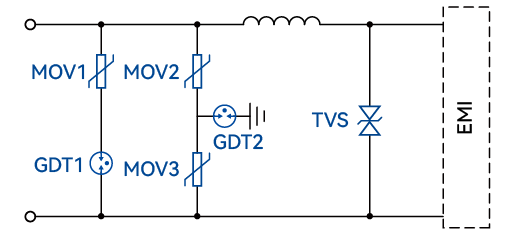
Figure 2: Power Surge Protection Solution
| PoE Power Port Over-voltage Protection Solution
| Surveillance Display ESD Protection Solution
| MCU ESD Protection Solution
The core components of devices like cameras, smart locks, video monitors, and switches are often semiconductor elements (e.g., CMOS, MCUs, sensors). Their internal structures, such as PN junctions and oxide layers, can break down or melt under the effect of even a few dozen volts of static electricity, causing permanent damage. As shown in the figures below, installing corresponding ESD suppressors (ESD TVS) in front of these sensitive electronic components can meet the electrostatic level test requirements of Class 1 to Class 4 in GB/T 17626.5-2019 for electromagnetic compatibility testing and measurement techniques for surge (impact) immunity.
Note:
Surge meets IEC 61000-4-5, combination wave 6 kV Impulse.
ESD meets IEC 61000-4-2 Class 4 (Con: 8kV, Air 15 kV).
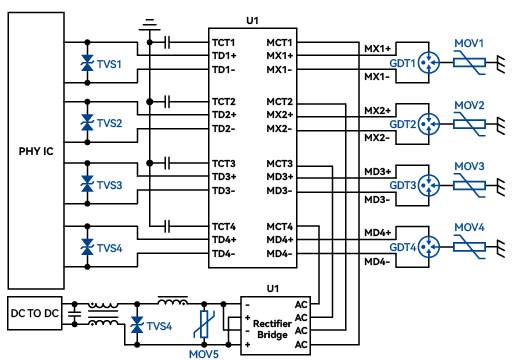
Figure 3: PoE Power Port Over-voltage Protection Solution
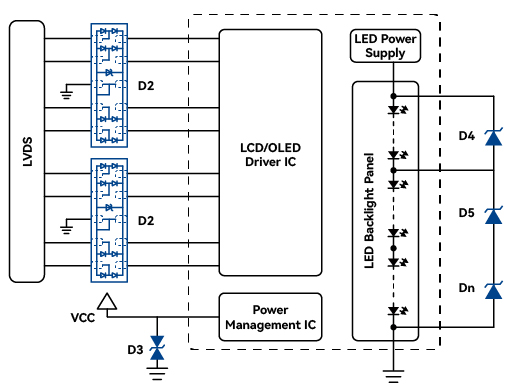
Figure 4: Surveillance Display ESD Protection Solution
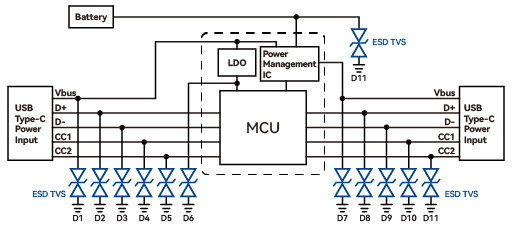
Figure 5: MCU ESD Protection Solution
| Device Short-circuit Protection Solution
Short circuits can occur at camera power interfaces due to frequent plugging and unplugging, or on interface cables of optical transceivers and switches due to damaged insulation. This can lead to equipment shutdown or burnout. In back-end processing equipment like NVR/DVRs, poor hard drive interface contact or bulging/leaking mainboard capacitors can cause a short circuit and data loss. Since security systems typically operate continuously for 24 hours, conventional current fuses have a certain impedance. SETsafe | SETfuse's RXF (Fusible Wirewound Resistor) and TRXF (Thermal-Link & Fusing Resistor) can be used, with impedance as low as 0.1Ω to reduce power consumption.
TRXF (Thermal-Link & Fusing Resistor)
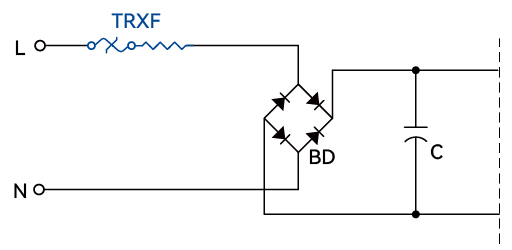
Advantages:
Excellent suppression of inrush current and lightning surges, and very good protection against minor fault currents and short circuits.
Electrical Safety Level: High.
Application: Small-power supplies with high safety requirements, where lightning surges are below 3 kV and the total machine power generally does not exceed 20 W.
RXF (Fusible Wirewound Resistor) + TRXF (Thermal-Link & Fusing Resistor)
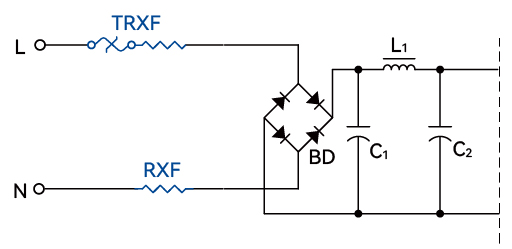
Advantages:
Excellent suppression of inrush current and lightning surges, and very good protection against minor fault currents and short circuits.
Electrical Safety Level: High.
Application: Small-power supplies with high safety requirements, where lightning surges are (4 ~ 6) kV and the total machine power generally does not exceed 3 W.
For more information, please contact: sales@SETfuse.com
































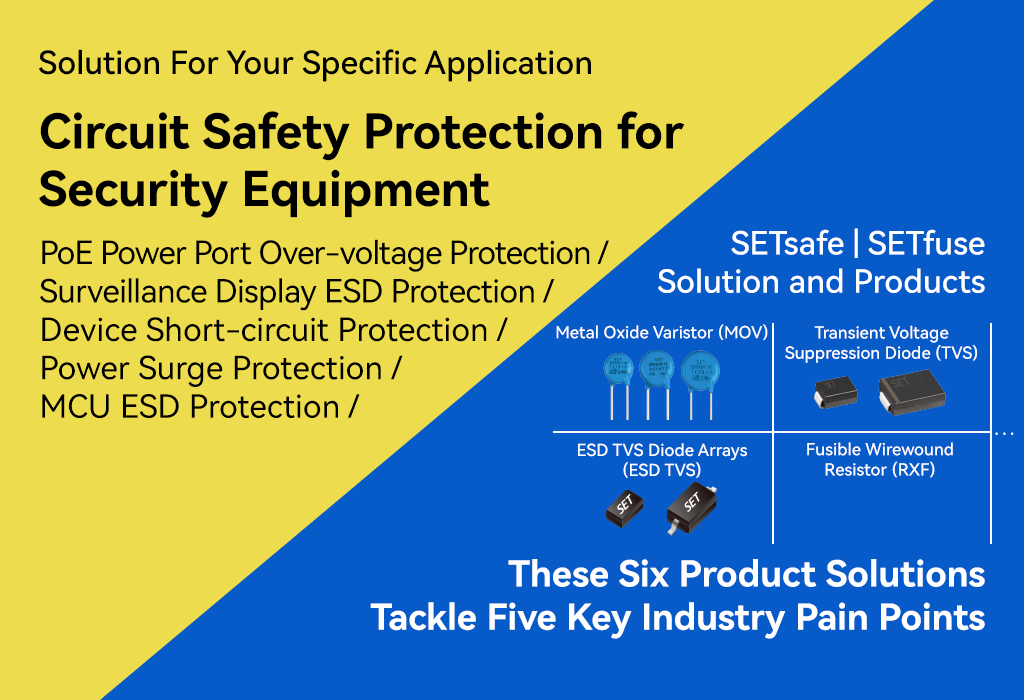

 Rechargeable Battery
Rechargeable Battery Lithium Battery Thermal Runaway
Lithium Battery Thermal Runaway Electric Power Tool
Electric Power Tool New Energy
New Energy PV Power Generation
PV Power Generation Wind Power Generation
Wind Power Generation Energy Storage Batteries
Energy Storage Batteries Energy Storage System (ESS)
Energy Storage System (ESS) Electric Vehicles
Electric Vehicles EV Charging Stations
EV Charging Stations Light Electric Vehicles
Light Electric Vehicles Home Appliances
Home Appliances Small Household Appliances
Small Household Appliances Large Home Appliance
Large Home Appliance Home Appliance Component
Home Appliance Component Kitchen Appliances (Hotplates ...)
Kitchen Appliances (Hotplates ...) Air Fryer
Air Fryer Coffee Machine
Coffee Machine Electric Iron
Electric Iron Smart Toilet
Smart Toilet Personal Digital Products
Personal Digital Products Lifestyle Appliances
Lifestyle Appliances Office Equipment
Office Equipment Walkie Talkie
Walkie Talkie Medical Analysis Instrument
Medical Analysis Instrument Medical Auxiliary Facility
Medical Auxiliary Facility Medical Instrument
Medical Instrument Lighting
Lighting Indoor Lighting
Indoor Lighting Outdoor Streetlight
Outdoor Streetlight Power Supply
Power Supply Power Supply (Power < 20 Watts)
Power Supply (Power < 20 Watts) HVDC in Data Centers
HVDC in Data Centers Power Supply Unit (PSU)
Power Supply Unit (PSU) Battery Backup Unit (BBU)
Battery Backup Unit (BBU) Uninterruptible Power Supply (UPS)
Uninterruptible Power Supply (UPS) Telecommunication
Telecommunication Automotive
Automotive Power Strip
Power Strip Surge Protection Power Strip
Surge Protection Power Strip Security & Protection
Security & Protection Tethered Drone
Tethered Drone Industrial Robot
Industrial Robot Humanoid Robot
Humanoid Robot Service Robot
Service Robot Specialty Robot
Specialty Robot Agricultural Irrigation Equipment
Agricultural Irrigation Equipment Smart Agricultural Greenhouse
Smart Agricultural Greenhouse Rail Transit Facility
Rail Transit Facility Rail-Vehicle
Rail-Vehicle Railway Power Supply
Railway Power Supply Fuel Dispenser
Fuel Dispenser Traffic Control System
Traffic Control System Traffic Signal Light
Traffic Signal Light Commercial Cleaning Equipment
Commercial Cleaning Equipment Delivery Locker (Drone)
Delivery Locker (Drone) Vending Machine
Vending Machine Lightning Protection Components
Lightning Protection Components HVAC Rooftop Systems
HVAC Rooftop Systems Outdoor Electric Wall Mounted Heater
Outdoor Electric Wall Mounted Heater Flag Explain
Flag Explain









































